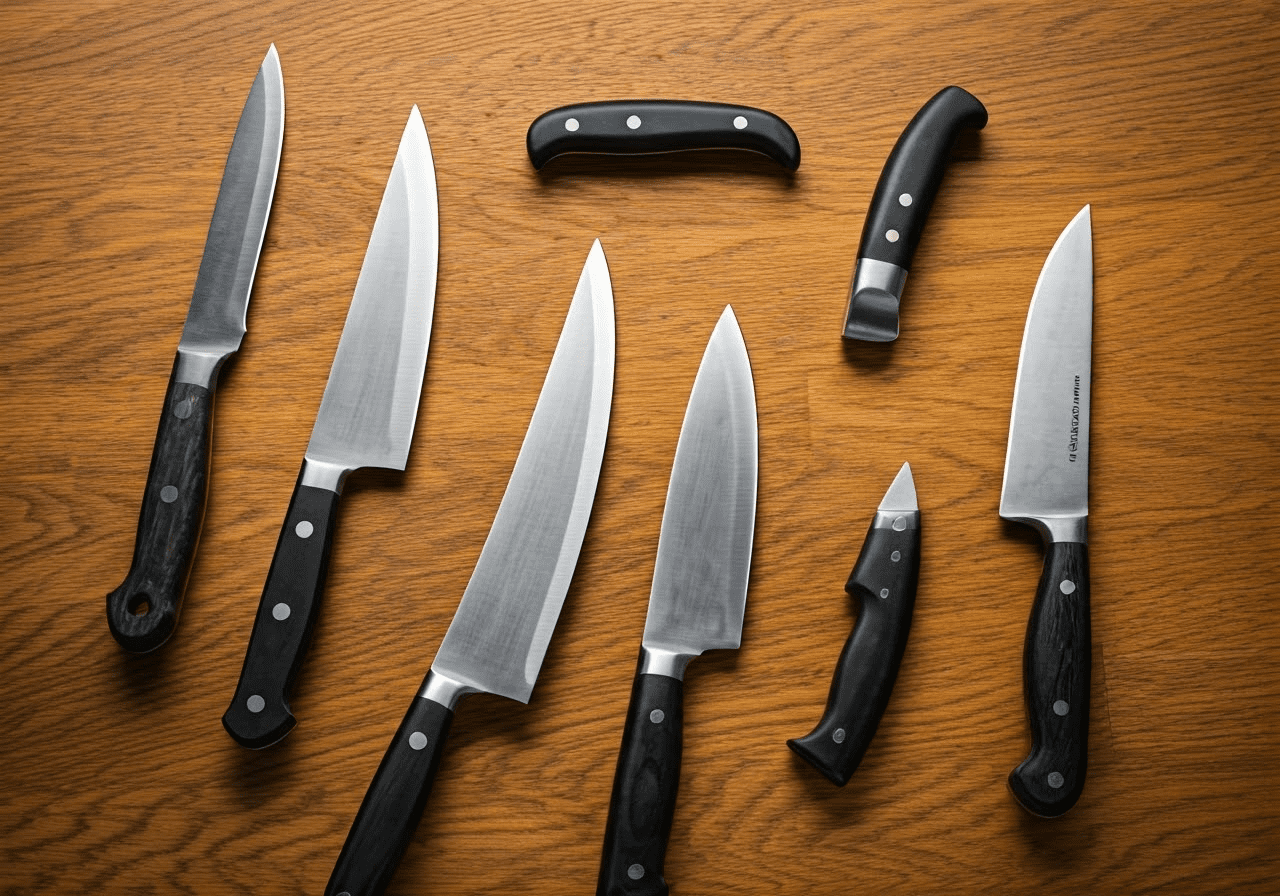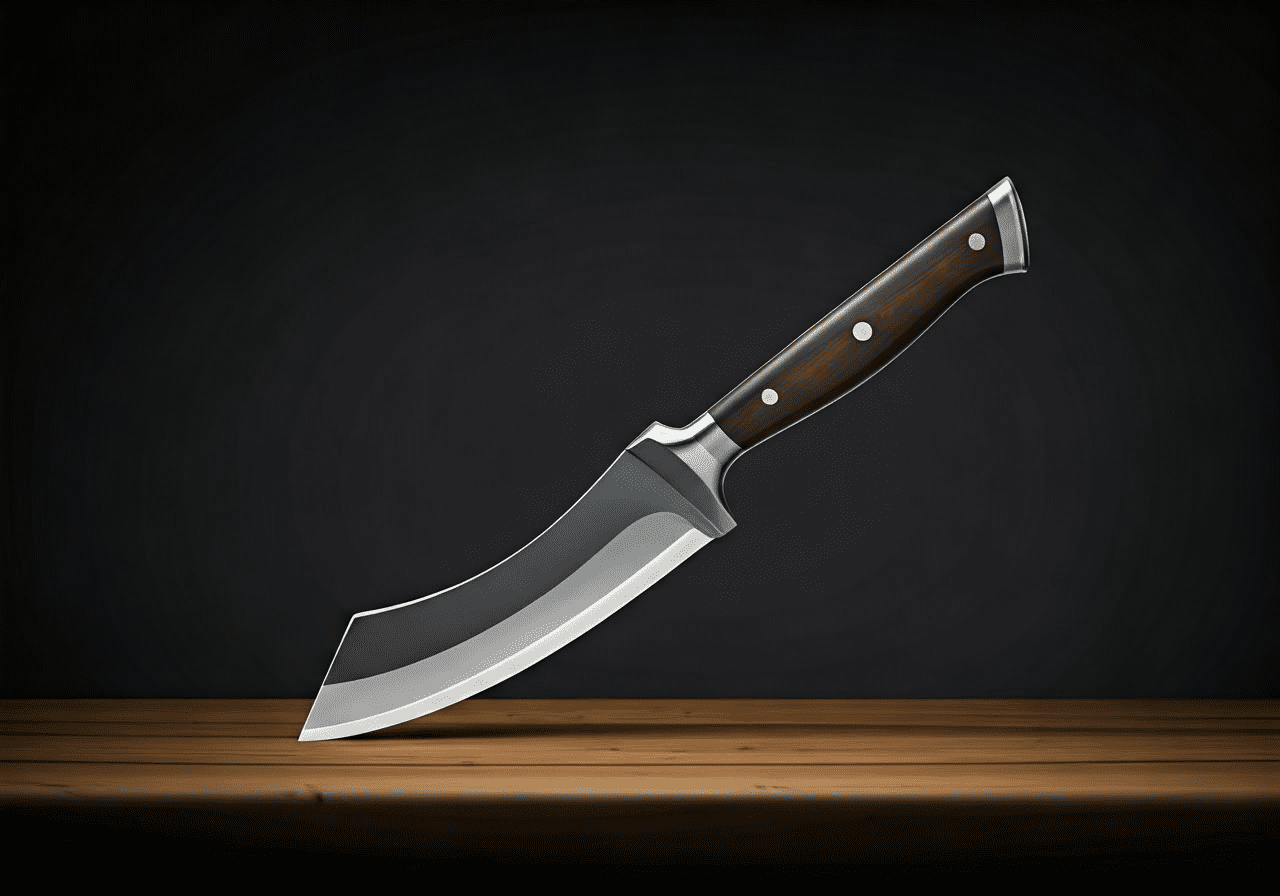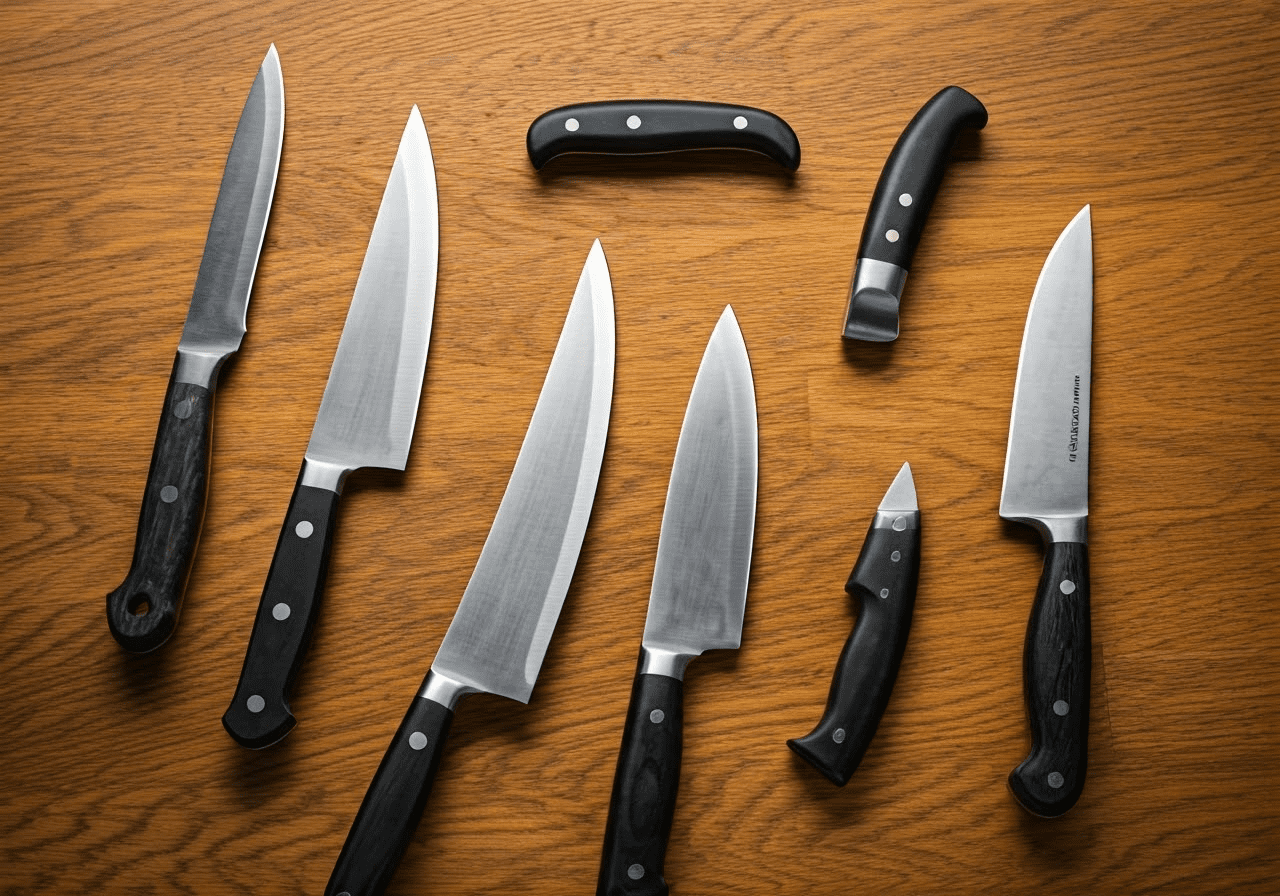
Table of Contents
Key Highlights
- Curved knives excel at precision tasks like peeling, slicing, and chopping.
- The curved blade allows for a rocking motion, reducing strain and improving efficiency.
- From peeling ginger to slicing tomatoes, curved knives offer versatility in the kitchen.
- Bird’s beak knives are specialized curved knives ideal for intricate work.
- Understanding the pros and cons of curved blades helps make informed choices for your culinary needs.
Introduction
A curved knife is popular in both professional kitchens and home cooks’ kitchens. Its special design offers good precision and many uses. This tool can really help you with food prep. But what features make a curved knife different? And is it the best choice for your cooking style?
Understanding the Unique Design of Curved Knives

At first, the most noticeable part of a curved knife is its curved blade. This unique shape looks good and has a real purpose. The curve helps it rock back and forth on the cutting board. This is helpful when mincing, chopping, and cutting fine slices. The rocking motion also reduces strain on your wrist, so it’s comfy to use for a long time.
A straight blade often needs more up-and-down motions. In contrast, the curved blade easily moves through food. This makes it great for peeling fruits and vegetables, where you want a clean, smooth cut. Some curved knives, like the bird’s beak knife, are made for delicate tasks. They are perfect for removing marks from potatoes or making fancy garnishes.
The Historical Significance of Curved Blades
The idea of the curved blade goes back much further than our kitchens today. Its roots can be found many years ago in the design of swords. The curved sword, known in many cultures, showed how useful this shape could be in fights.
The curved design worked really well for slashing and moving around in close quarters fights. It could cut through armor easier than some straight swords. This made it a strong weapon in history.
Key Design Features of Curved Knives
The curved blade is one important feature, but there are other design elements that help these knives work better.
Many curved knives, like paring knives, have shorter blades. This design helps with small tasks where control is very important. The handle also matters. A good handle gives a comfortable and secure grip, even if it gets wet. This helps keep precision and makes it safer to use the knife.
The weight is evenly balanced in the wielder’s hand. This balance is key for getting clean and even cuts, especially during tasks that need to be done multiple times.
What is the reason for a curved blade?
The curved blade has a special shape that offers many benefits. This is why both professional chefs and cooking enthusiasts like to use it. The main reason for its design is its ability to improve precision and efficiency while cutting.
The curve allows a rocking motion that makes it easier to chop herbs, mince garlic, or slice vegetables evenly and thinly. This natural motion also helps lessen wrist strain, making it comfortable to use for a longer time.
Why is a curved blade better than a straight blade?
The choice between a curved blade and a straight blade often depends on the task and what you like. There are some situations where a curved blade is better.
Using a curved blade lets you rock it back and forth. This makes mincing and chopping faster and requires less effort. The curved shape gives a smooth and controlled cut, especially with delicate items. However, a disadvantage of curved blades is that they might not work for every cutting technique. Straight blades, in comparison, work great for tasks that need a direct and firm cut. This includes slicing bread or filleting fish.
What is the bent knife for?
The “bent knife” usually means curved paring knives or special knives like the bird’s beak knife. These knives are very helpful in the kitchen. Their shape helps with tasks that need accuracy and a gentle touch.
These knives are great for peeling fruits and vegetables. The curved blade lets you cut close and with control. They are also good for making garnishes, like radish roses or citrus twists, because they are easy to move. Additionally, the pointed tip of many bent knives works well for getting rid of marks on produce or hulling strawberries.
Why are carving knives rounded?
Carving knives usually have a rounded tip. This design helps with precision and safety when slicing cooked meats. The rounded tip of a curved knife stops the blade from accidentally piercing the meat. This gives you clean and nice slices.
The shape of the blade lets it move easily along the meat’s contours. It follows the natural curves without trouble. Whether you are carving a roast chicken, a Thanksgiving turkey, or a holiday ham, the rounded blade helps you make even slices. It will not tear or shred the meat.
Not every carving knife is curved, but the rounded tip is an important feature. It focuses on safety and precision. The ability to create good-looking, even slices makes the rounded carving knife a useful tool for both home cooks and professional chefs.
What is the most useful knife shape?
Choosing the “best” knife shape is often a personal choice. It really depends on what you need and how you cook. Both curved blades and straight blades are important in a good kitchen.
Paring knives with either a curved or straight blade are handy for many small jobs. Meanwhile, a curved chef’s knife or a santoku knife can make work easier when you need to chop, mince, or slice vegetables.
In the end, you should pick knives that fit your cooking style. Using a mix of curved and straight blades will give you the best options for any cooking task.
What is that curved knife called?
Curved knives are a group of tools that come in different types. Each type has its own name based on its shape and use. One well-known curved knife is the bird’s beak knife. It is also called a tourné knife sometimes.
This small tool is strong and has a sharply curved blade. The shape looks like a bird’s beak. It is great for detailed jobs like peeling soft fruits, cleaning shrimp, or making pretty garnishes.
Another type is the sheep’s foot knife. It gets its name from its short, rounded blade that looks like a sheep’s hoof. Sailors often use this knife because it has a safe and practical blade for many cutting tasks.
What is the purpose of a crooked knife?
The term “crooked knife” usually means a special tool used in woodwork. It is mainly for artisans and craftspeople. A crooked knife has a curved blade and often a bent handle. This design makes it perfect for carving items like spoons, bowls, and other wooden things.
The curved blade gives precision. This allows for controlled cuts and helps in making detailed and smooth curves in wood. The bent handle helps with leverage and control. This lets craftspeople make precise cuts more easily.
What is the famous curved knife?
The world of curved knives has many famous designs. Each one has its own historical importance and a strong fan base among enthusiasts. A well-known example is the Nepalese Kukri knife.
This special knife has a striking curve and a heavy blade. For centuries, it has been used as both a tool and a weapon in Nepalese culture. Its unique shape helps create a strong chopping action. This makes it great for clearing brush, cooking food, and even for fighting.
Why are knives shaped the way they are?
The design of a knife is carefully made to help it work better for different jobs. Curved blades and straight blades each have their own good and bad points. They are used for different cutting styles and kitchen needs.
Curved blades are great for jobs like chopping herbs, mincing garlic, or peeling round fruits. The curve helps the knife move smoothly through food, making it easier and less tiring for the wielder’s wrist. On the other hand, straight blades are best for tasks where you need a strong, single cut, such as slicing bread or filleting fish.
Why are some daggers curved?
Throughout history, different cultures have used curved swords and daggers in their weapons. Curved daggers, in particular, are useful in certain fights.
The curved blade of a dagger works well in close quarters. In these situations, slashing and hooking are very important. The curve helps the wielder move the dagger in many directions, making it easy to strike from various angles. Although curved daggers are not great for thrusts, they are good at making deep, slashing wounds. This shape also makes it hard for an opponent to block or parry the attack successfully.
Why are butcher knives curved?
Butcher knives are important tools used for preparing meat. They usually have a curved blade that makes it easier to cut through meat and bone. This curved knife design allows you to use a rocking motion, which is helpful for dividing large pieces of meat.
The curve of the blade gives you better leverage. This means it’s simpler to cut through tough tendons and cartilage. The rocking motion also makes skinning and trimming easier. This results in a smoother and more controlled cut.
Why is my knife curved?
If you have a curved blade knife and are curious about what it’s used for, you are not the only one! Many knives are designed with a curve to help with special cutting techniques and make them easier to use.
The curve lets you rock the knife back and forth on the cutting board. This is great for tasks like mincing, chopping, and making thin slices. It helps lessen wrist strain and boosts precision. Plus, a curved blade can make peeling fruits and vegetables easier. It allows the knife to follow the shape of the produce better.
The Versatility of Curved Knives in Culinary Arts
Curved knives are now a staple in both professional and home kitchens. They are popular because they can do many different tasks. You can use them for gentle peeling or accurate slicing. This makes them essential for both detailed food prep and regular cooking.
Precision Cutting and Slicing Techniques
A curved knife is great for cutting and slicing with precision. Its shape helps with a rocking motion. This makes it easy to make thin and even cuts of herbs, vegetables, and fruits.
The curved blade stays in touch with the cutting board during this rocking motion. This gives you better control and accuracy. It is especially helpful for chopping herbs, slicing soft tomatoes, or making very thin cucumber ribbons.
Specialized Uses in Food Preparation
Curved knives are very helpful in the kitchen, especially for certain tasks. Their shape helps with jobs that need care and accuracy.
A common use is for peeling fruits and vegetables. The curved blade makes peeling smooth and even. This also helps to reduce waste. Curved knives are also good for making garnishes. Their design helps you make fancy cuts that make dishes look better.
Comparing Curved and Straight Knives
The choice between curved and straight knives depends on personal likes and what you plan to use them for. Each type has its own good points and bad points.
Knowing these differences can help you pick the right knife when you want to add to your collection or find the best tool for a cooking job.
Benefits of Using a Curved Knife
The curved blade has many benefits, which is why it is loved by both experienced chefs and cooking enthusiasts. Its good design helps prevent strain during long tasks. The rocking movement is great for fast chopping and slicing.
You can see the precision of a curved blade clearly when you are working with delicate foods or making detailed cuts.
Situations Where Straight Knives Excel
While curved blades have many benefits, straight blades are important in the kitchen for certain jobs.
For example, when you need a clear cut, like slicing bread or filleting fish, a straight blade works best. The paring knife, which usually has a straight blade, is great for careful jobs. It can help with tasks like taking seeds out of fruits or coring apples.
Conclusion
Curved knives have a long history and a special design that help with cooking tasks. They cut with great precision and are important for some jobs in the kitchen. Curved blades are great for efficient slicing, while straight knives work better in other situations. If you understand how useful curved knives can be, it can improve your cooking skills. By learning why they are made this way and how they are used, you will see the skill involved in making these important kitchen tools. A curved knife is perfect for carving, slicing, or detailed food prep. It can add a special touch to your cooking.
Frequently Asked Questions
What Makes Curved Knives Preferable for Certain Tasks?
The curved blade helps create a rocking motion. This improves precision and speed when you chop herbs, mince garlic, or peel fruits. The design also helps reduce wrist strain, especially when you do a lot of cutting.
What is the point of a curved knife?
A curved knife helps with precision and control. This makes it great for peeling, chopping, and slicing. The curve allows for a rocking motion. This reduces the effort needed and helps the wielder make more accurate cuts.
What is the curved knife for?
A curved knife is very useful. It is great for tasks such as peeling, slicing, and making garnishes. The curved blade is good for making accurate cuts. It also lets you rock the knife smoothly on the cutting board.
What is the reason for a curved blade?
A curved blade helps you rock as you chop and mince. This shape makes it easier to cut with accuracy. Many home cooks love using a curved blade because it is efficient and makes their tasks simpler.
Why are curved blades better for cutting?
The curved blade helps create a rocking motion. This makes it easier to make longer and smoother cuts. You won’t have to use much effort. This motion also increases precision. It’s especially helpful for tasks like mincing and slicing.
What are deeply curved blade knives for?
Deeply curved blades, which you often find in knives like the bird’s beak, are great for detailed jobs. The strong curve helps the wielder come very close to the cutting surface. This makes them perfect for gentle peeling and making beautiful garnishes.


